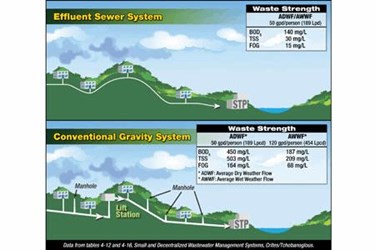Pressure Sewers Can Save Millions

Alternative wastewater collection systems, such as pressure sewers, provide affordable service to municipalities, new subdivisions, and areas where gravity sewers are difficult and expensive to install. They can potentially save millions of dollars in contrast with the option of gravity sewer.[i] As opposed to the “big pipes” and deep excavations typically required by gravity sewers, pressure sewers use small-diameter, shallowly-buried mainlines that follow the contour of the land and are easily installed with light-duty equipment.
Because of their affordability, pressure sewers have been installed in thousands of communities over the past several decades. Many of these sewers are now more than 30 years old. Two of these technologies, effluent sewer and grinder sewer, are being proposed in an increasing number of municipalities and new developments.
Although pressure sewer technology appears to be an ideal solution for smaller communities, many engineers continue to recommend conventional gravity sewers. One reason is the misconception that pressure sewers are more expensive to operate and maintain than gravity sewers.[ii] In the past, operational data from long-term pressure sewer systems hasn’t been readily understood, mainly because of the variety of data, variability in equipment quality, variability in operational and management procedures, and a simple lack of documentation.
Because of these unknowns, consultants have typically overestimated the operation and maintenance costs of pressure sewer systems. Ironically, consultants have also commonly underestimated the operation and maintenance costs of conventional gravity sewer systems.
Today, however, enough data is available to accurately estimate pressure sewer costs for preventive maintenance, reactive maintenance, equipment repair and replacement, and solids management. In fact, the actual costs for decentralized systems like an Orenco Sewer™ (a type of effluent sewer also known as a STEP or STEG system) are a fraction of those for centralized gravity systems.[iii] With effluent sewers, for example, a single employee can provide operation and maintenance services for more than 1,000 residential connections.
And on the subject of capital costs, gravity sewers can be too expensive for rural communities and smaller municipalities, because these communities lack a large, dense user base to provide economies of scale.[iv] Orenco Systems® has collected and analyzed constructed costs from more than forty publicly funded and bid collection systems – including Orenco effluent sewers, gravity sewers, and grinder sewers – serving small communities. Based on that analysis, Orenco Sewers cost 41% less than gravity sewers.[v]
In 2010, when the Water Environment and Reuse Foundation developed its “Fact Sheets” and “Wastewater Planning Model” for effluent sewers, grinder sewers, vacuum sewers, and gravity sewers, its research showed that effluent sewers are the lowest-cost alternative when considering up-front and life-cycle costs.[vi] The WERF Fact Sheets include design characteristics, performance data, and costs for each collection system technology. And the Wastewater Planning Model is a cost-estimating tool that allows users to compare the capital and life-cycle costs of each type of sewer.
While it’s true that every sewer technology has its place, pressure sewers are more affordable and sustainable than many designers realize. Municipalities and their consultants can now use long-term data to evaluate pressure sewers, along with other technologies, to determine the solution with the lowest life-cycle cost. This kind of accurate, long-term cost data is critical – not only for evaluating and selecting sewer technologies, but also for establishing customer rate structures that cover the full range of actual life-cycle costs.
[i] Orenco Systems, “Vero Beach Project Profile,” (Sutherlin, Oregon: Orenco Systems, 2017), 2.
[ii] Bill Cagle, Terry Cargil, and Roger Dickinson, “20-Year Life Cycle Analysis of an Effluent Sewer (STEP) System, City of
Lacey, Washington,” (Sutherlin, Oregon: Orenco Systems, 2013), 1.
[iii] USEPA, Response to Congress on Use of Decentralized Wastewater Treatment Systems (Washington, D.C.: USEPA, 1997), 13-14.
[iv] Water Environment & Reuse Foundation, “Fact Sheet C1: Gravity Sewer Systems” (Alexandria, Virginia: WERF, 2010) 1.
[v] Orenco Systems, “Small Community Collection Systems: Construction Costs,” (Sutherlin, Oregon: Orenco Systems, 2014), 1-2.
[vi] “Decentralized Systems Performance and Costs Fact Sheets,” Water Environment & Reuse Foundation, accessed April 25, 2017, http://www.werf.org/i/c/DecentralizedCost/Decentralized_Cost.aspx.
